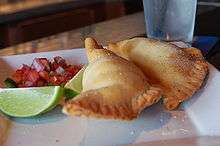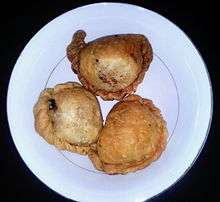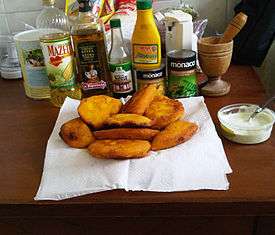Empanada
 Two empanadas (empanadillas) | |
| Course | Appetizer |
|---|---|
| Place of origin | Spain, Portugal |
| Region or state | Latin America, Europe |
| Creator | Spain |
| Serving temperature | Hot or cold |
| Main ingredients | Pastry, filling |
| Variations | Pastel, Pasty |
|
| |

An empanada (Spanish pronunciation: [empaˈnaða]) is a stuffed bread or pastry baked or fried in many countries in Spain and Latin America. The name comes from the Spanish verb empanar, meaning to wrap or coat in bread.
Empanadas are made by folding dough over a stuffing, which may consist of meat, cheese, huitlacoche, or other ingredients.
Origins
Empanadas trace back their origins to the northwest region of Spain, Galicia.[1][2][3] A cookbook published in Catalan in 1520, Libre del Coch by Robert de Nola, mentions empanadas filled with seafood in the recipes for Catalan, Italian, French, and Arabian food.[4][5]
Some sources claim a connection with the Indian cuisine, but this is disputed. A similar dish first appeared in Portugal around the time of the establishment of trade routes to India and the establishment of a colony at Goa. This is believed to have been derived from or influenced by the Indian Gujia or Samosa, known in Lisbon as the Chamuça da Goa.[6]
By country and region
Argentina
Argentine empanadas are often served during parties and festivals as a starter or main course. Shops specialize in freshly made empanadas, with many flavors and fillings.
The dough is made with wheat flour and beef drippings for the fillings which differs from province to province. Some places use chicken, and some places beef (cubed or ground depending on the region) spiced with cumin and paprika. Some other fillings are onion, boiled egg, olives, or raisins. Empanadas can be baked (Salta-style) or fried (Tucuman-style). It also can contain ham, fish, humita (sweetcorn with white sauce), or spinach; a fruit filling is used to create a dessert empanada. For the interior regions, they can be spiced with peppers.
In those places (usually take-out shops) where several types are served, a repulgue, or pattern, is added to the pastry fold to distinguish the varieties (although it is more common nowadays to burn a letter – an abbreviated indication of the filling – into the dough). In larger cities, empanadas are eaten more as take-away food, sourced from restaurants specializing in this dish. They usually carry dozens of different varieties, which is not the case in northern provinces, where empanadas are usually made at home, with more traditional recipes.
During Lent and Easter, empanadas de Cuaresma fillings with fish (usually dogfish or tuna) are popular.[7]
Also popular are the so-called "Arabian" empanadas (empanadas árabes or fatay), filled with beef, tomato, onion, and lemon juice, similar to the fatayer made in the Levant.
Belize

In Belize, empanadas are known as panades. They are made with masa (corn dough) and typically stuffed with fish, chicken, or beans.[8] They are usually deep fried and served with a cabbage or salsa topping. Panades are frequently sold as street food.[9]
Cape Verde
Cape Verde cuisine features the pastel, as well. Cape Verdean pastéis are often filled with spicy tuna fish. One particular variety, the pastel com o diabo dentro (literally: Pastel with the devil within), is particularly spicy, and is made with a dough made from sweet potatoes and cornmeal.[10]
Chile
In Chile, the most traditional empanada filling is called "pino". Pino is a seasoned mixture of ground beef, onions, raisins, black olives, and hard boiled eggs. The empananda dough is quick and easy to make, and can be made ahead and stored in the refrigerator. The pino tastes best if made the day before and allowed to rest overnight before filling the empanandas..
Colombia
Colombian empanadas are made with maize meal (same as arepas) and filled with potatoes and meat which are previously stir-fried with spring onion, tomatoes, garlic and cumin. Empanadas are usually fried, but can be prepared in oven. Empanadas are accompanied by different preparations of chili sauces including encurtido (mix of various onions, tomato, fresh coriander, vinager and lime), peanut chili sauce, or chili sauce. Empanadas are consumed like snacks between breakfast and lunch or between lunch and dinner.
India
In Indian cuisine, there are many varieties of empanadas—mostly with sweet fillings. In North India (Uttar Pradesh, Madhya Pradesh and Rajasthan), they are called gujias. Gujias are sweet and are made typically at festival time—especially Holi. They are made with a filling of dry fruits, khoya, etc. In South India they are called Karjikayi or Kajjikaya (Telugu).
In Tamil nadu and Puducherry/Pondicherry they are called somasam or Somas they are usually stuffed with dry filling made of coconut , roasted bengal gram(pottu kadalai)or rava, cashew nuts and sugar. Somasam is one of the main diwali sweet. Somasam recipe . The fillings are usually dry so that the sweet can be stored for weeks.
In Maharashtra they are made during the Ganapati festival and also for Diwali—they are called Karanjis. In Gujarat they are called Ghugra.
In Goa, In Goa, Hindu families prepare Nevriyos are made specially for Ganeshotsav, they of two types of stuffings one with Puran of Bengal gram, Jagerry and Elaichi. It is also called panch khadi mostly it made by Gaud Saraswat Community i.e if in five different forms Nevri,Modak, karmal , Bimbal& puri. Second type is made out of dry desiccated coconut, khus khus, Sugar elaichi cashew nuts. covered with dough of Maida and Rava which makes Nevri Crispy
Catholics make two variants: one for Christmas with a coconut, jaggery and dry fruit filling called Neories/ Nevries, and patties (pattisam) made all year round with beef and/or certain vegetables.
Indonesia
In Indonesian cuisine, a panada is a bread snack filled with spicy tuna or cakalang fish (skipjack tuna). It is derived from the Portuguese empanada. It is the specialty of Manado city, Minahasa people, North Sulawesi, Indonesia.[11]
Marianas Islands
The Chamorro people of Guam and Saipan make an empanada filled with ground, toasted rice, red chili, black pepper, garlic, and annatto. The pastry is made from masa harina and is deep fried.[12]
Mallorca (Spain)
In the Balearic Islands there are panades (Mallorca) and formatjades (Menorca), filled usually with meat or vegetables, or the two things at once. When formatjades are filled with cheese are called 'flaons'. In Mallorca are made cocarrois stuffed with chard, cauliflower, spinach, almonds, raisins, pine nuts or onion. A smaller version is also made. It consists of a small round wafer folded in half, with sweet fillings or salted, fried or baked. In the sixteenth century, like those made with the bread dough, they were called "English empanadas".
Philippines

Filipino empanadas usually contain ground beef, pork or chicken, potatoes, chopped onions, and raisins (somewhat similar to the Cuban picadillo) in a somewhat sweet, wheat flour bread. There are two kinds available: the baked sort and the flaky fried type. To lower costs, potatoes are often added as an extender, while another filling is kutsay, or garlic chives (kutsay in Cebuano and Tagalog; 韭菜 kú-chhài in Lan-nang).
Another traditional Filipino empanada which is currently experiencing a revival is the empanada de calisquis, which has a very flaky, crust somewhat similar to flaky pastry, but has a crunchier mouth-feel due to it being deep-fried. Calisquis (kaliskis) translates to (fish) scales, as the flakes of the crust resemble scales coming off.
Empanadas in the northern part of the Ilocos are different. These usually have savoury fillings of green papaya, mung beans, and sometimes chopped Ilocano sausage (chorizo) and egg yolk.[13] Rather than the soft, sweet dough favoured in the Tagalog region, the dough used to enclose the filling is thin and crisp, mostly because Ilocano empanadas use rice flour coloured orange with achuete (annatto), and is deep-fried rather than baked.[14]
Sardinia (Italy)
In Sardinia, a panada is a pie filled with lamb, potatoes, sundried tomatoes, onions, garlic, saffron, etc.[15]
Sicily (Italy)
The 'Mpanatigghi are stuffed, consisting of halfmoon-shaped panzarotti filled with a mixture of almonds, walnuts, chocolate, sugar, cinnamon, cloves and minced beef.[16][17][18] These are typical of Modica, in the province of Ragusa, Sicily. They are also known as impanatiglie or dolce di carne ("pastry of meat").[19]
They were probably introduced by the Spaniards during their rule in Sicily which took place in the sixteenth century; this is suggested from the etymology of the name which comes from the Spanish "empanadas or empadillas" (empanada), as well as from the somewhat unusual combination of meat and chocolate, which occurs several times in the Spanish culinary.[16][17][20] In past centuries for the preparation of 'mpanatigghi game meat was used but today beef is used.[16]

United States
Empanadas, mainly based on South American recipes, are widely available in New York City from food carts, trucks, and restaurants.[21]
Venezuela
Venezuelan empanadas differ form other countries' (such as Argentina and Chile) in that they are made with corn flour instead of wheat flour. Venezuelan empanadas, akin to empanadas in other countries in the Caribbean, are generally fried instead of baked. The dough for Venezuelan empanadas is made similarly to the arepa dough, using corn flour, water and salt. In some cases the flour can be flavored with any desired ingredient, such as sugar cane, anise, annatto or just broth.[22]
Similar dishes
Many other world cuisines have dishes very similar to the empanada. These include:
- Bánh gối (bánh xếp) and other types of bánh from Vietnam
- Börek and pogača from Turkey and areas of the former Ottoman Empire
- Bridie, baked pastry filled with spiced beef and onions, from Forfar, Scotland.
- Calzone and panzerotti from Italy
- Curry puff from Malaysia and countries with Malay populations
- Goat roti, goat curry in flatbread from the east of India
- Gujia from India filled with sugared coconut, nuts, and sweets, but no meat
- Jamaican patty
- Jiaozi from China, also called mandu in Korea and gyōza in Japan
- Kajjikaya from Andhra Pradesh, India, similar to fried empanadas filled with sweetened, dried coconut
- Khuushuur, from Mongolia, commonly made with mutton or beef, or whitefish when within the vicinity of Lake Khuvsgul.
- Kibbeh, from Lebanon/Levant, with lamb meat encased in bulgur dough
- Karanji from Maharashtra, India, filled with fried and sugared coconut
- Knish, a dish from Eastern Europe
- Kubdari, a traditional dish of Svan people in Georgia
- Momo, deep-fried, from Tibet, Nepal, and northeast India
- Natchitoches meat pie, fried or baked pastry turnover filled with ground beef, pork, onion, garlic, and spices
- Pastel, a similar Brazilian dish with a more flaky, pastry-type crust
- Pasty, Cornish baked pastry filled with beef and potato, from Cornwall, England
- Pierogi, bierock and runza from Slavic countries and the Midwestern United States
- Pīragi or pīrādziņi from Latvia
- Pirozhki or Chiburekki, from Russia and nearby countries
- Samosa, from South Asia
- Scovardă, mainly used in the plural scoverzi, from Romania, especially Transylvania, fried in a pan and usually filled with various types of cheese, with or without dill
- Stromboli (which is Italian American)
- Hot Pockets, prepared, mass-marketed food from the United States
- Strudel, from Germany and areas of the former Habsburg Empire
See also
References
- ↑ "Historia de la empanada criolla" (PDF). Dra. Susana Barberis. Retrieved 8 July 2010.
- ↑ Penelope Casas (1982), The Food, Wines, and Cheeses of Spain, Alfred A. Knopf, New York 1982 (p. 52)
- ↑ "Breve historia de la alimentación en Argentina". Liliana Agrasar. Retrieved 8 July 2010. They first appeared in medieval Iberia during the time of the Moorish invasions.
- ↑ Adamson, Melitta Weiss (2004). Food in medieval times. Greenwood Publishing Group. ISBN 0-313-32147-7.
- ↑ Lady Brighid ni Chiarain. "An English translation of Ruperto de Nola's Libre del Coch". Stefan's Florilegium. Retrieved January 31, 2011.
- ↑ pt:Chamuça
- ↑ "Argentine Atún Empanadas". Retrieved 26 January 2015.
- ↑ "Belizean Food". Belize.com. ITM Ltd. Archived from the original on 1 December 2015. Retrieved 1 December 2015.
- ↑ Kraig, Bruce; Sen, Colleen Taylor, eds. (2013). Street Food Around the World: An Encyclopedia of Food and Culture. Santa Barbara, California: ABC-CLIO. p. 72. ISBN 978-1-59884-954-7.
- ↑ Hamilton, Cherie. 'Cuisines of Portuguese Encounters' Hippocrene Books. 2001.
- ↑ "Panada Recipe (Manado Tuna Stuffed Bread/Pastry)". Indonesia Eats. 4 September 2010.
- ↑ Chamorro empanada recipe
- ↑ Ian Ocampo Flora (April 23, 2010). "Vigan Empanada and the gastronomic treats of Ilocos". www.sunstar.com.ph. Retrieved 30 December 2010.
- ↑ "Vigan Empanada". www.fliptravels.com. April 29, 2010. Retrieved 30 December 2010.
- ↑ http://www.my-italy-piedmont-marche-and-more.com/food-in-sardinia.html
- 1 2 3 Red. Spe. (31 July 2013). "Quanto è "dolce" Ragusa". Corriere del Mezzogiorno.
- 1 2 Giovanni Assenza (2014). Miele, garofano, cannella. I profumi dei dolci di Sicilia. Assenza. ISBN 605-030-594-3.
- ↑ Nicky Pellegrino (2013). The Food of Love Cookery School. Hachette UK. ISBN 1-4091-3381-8.
- ↑ Monica Cesari Sartoni (2005). Mangia italiano. Guida alle specialità regionali italiane. Morellini Editore. ISBN 88-89550-05-8.
- ↑ Touring Club of Italy (2005). Authentic Sicily. Touring Editore. ISBN 88-365-3403-1.
- ↑ "10 Spots To Score Excellent Empanadas In NYC" by Angely Mercado, Gothamist, 13 October 2014;
"NYC Food Truck Lunch: Empanadas From La Sonrisa Empanadas" by Perry R., CBS New York, 9 October 2015 - ↑ "Venezuelan empanadas". Retrieved 16 September 2016.
External links
| Wikimedia Commons has media related to Empanadas. |
- How to Make Empanadas—Step-by-step guide with pictures on how to make empanadas.
